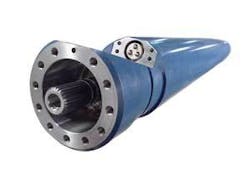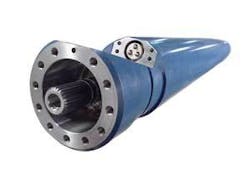Extending the life of mature fields
North Sea operator uses water resources, ESPs
Eugene Bespalov, Barry Irvine - Baker Hughes Centrilift
Operators in the northern North Sea are taking advantage of existing water resources and electrical submersible pumping (ESP) technology to extend the life of mature fields and at the same time lower operating expenses and minimize impact to the reservoir. Water injection for reservoir pressure maintenance is nothing new in the oil industry, but traditional offshore seawater injection applications can be costly and can potentially damage the reservoir and well equipment.
Use of compatible aquifer water for reservoir pressure maintenance provides a number of benefits that contribute to the optimization of the total asset value and return on capital investment in water flood projects. Of course, this approach is only possible in areas where suitable aquifers exist and the northern North Sea has a shallow, widespread aquifer ideal for these types of projects.
High volume with reduced formation damage
ESP systems provide the high volume lift solution for lifting the water to surface for re-injection into the producing formations. High volume aquifer ESP systems require no costly surface water injection plant, and well operating expenses are reduced due to the elimination of formation chemical treatments.
Produced aquifer water minimizes the possibility of chemical formation damage associated with injection of incompatible water. Scaling tendencies of a specific reservoir depend on reservoir fluid and injection water composition as well as reservoir temperature, injected water temperature, and pressure regimes. Scaling can be a significant issue with seawater injection due to differences in high sulphate content of the seawater and high concentrations of calcium, barium, or strontium ions in the formation water. The combination can result in precipitation of sulphate salts in the formation and the well.
A reservoir-compatible water source eliminates scaling tendencies. Aquifer water also can reduce the potential for reservoir souring and enhances the overall reserve recovery factor by minimizing formation damage and associated reservoir permeability reduction.
Shallow aquifers extend over both the UK and Norwegian sectors of the northern North Sea. Several field developments have employed aquifer/produced water injection with high volume ESPs to lift the aquifer source water to the surface.
Lower capital and operating expenses
In addition to limiting reservoir damage, aquifer injection systems lower capital and operating expenses by eliminating water treatment facilities normally required for seawater injection. Traditional seawater injection facilities include high volume seawater lift pumps, a vacuum tower for oxygen removal, course and fine filtration, as well as biocide injection and may also include sulphate extraction facilities to reduce scaling potential.
Aquifer water requires minimal or no treatment facilities on the surface and can be directly re-injected into the injection wells. These systems include one or several aquifer production wells, each equipped with a high volume ESP, surface injection pumps, and possibly de-gassing facilities prior to mixing aquifer water with produced water. Final injection pressure requirements are normally provided by surface water injection pumps.
Several North Sea fields currently employ aquifer production systems in conjunction with ESPs, including Chevron Captain, BP Harding, ExxonMobil Buckland in the UK sector, and Norsk Hydro Brage, Oseberg and Esso Ringhorne in the Norwegian sector. There is future potential for this type of system in a number of currently undeveloped heavy oil fields in the area in which the conservative estimate for total heavy oil in place in the UK continental shelf is approximately 10 Bbbl.
These heavy oil fields would likely require water flooding as a secondary oil recovery method, but the economics can be marginal. The lower initial capital investment necessary for an aquifer injection system, as well as the elimination of both regular scale squeezes (estimated at between $200,000 to $500,000) and scale removal programs traditionally associated with seawater injection, can be the difference in making these types of fields economically feasible.
Case history - Norsk Hydro Brage
The Brage field in the Norwegian sector of the North Sea has two Jurassic producing zones at approximately 2,100 m and 2,300 m total vertical depth. High levels of barium and strontium in the formation water meant that traditional seawater injection systems required comprehensive scale treatment programs for the production zones as well as all the downhole process equipment. Anticipated low specific activity contamination of the production equipment due to scale deposition also presented health risks and required additional contaminated equipment utilization programs.
The operator replaced the traditional seawater injection system with aquifer injection from the shallow Utsira reservoir, which extends from 58° north to 62° north over a distance of more than 300 km with a maximum sand thickness of 500 m and minimum sand thickness of 170 m around the Brage Field.
Two Utsira ESP wells were drilled to about 1,100 m measured depth and were completed with wire-wrapped screens in an open hole. The ESP systems consist of 13 pump stages and 1,150-hp submersible motors, each capable of delivering up to 80,000 b/d of water. Both wells use 1,300-kVA variable speed drives and consume around 500 to 600 kW at normal operating frequency.
The system design assumes one ESP running on a fixed operating frequency with a second system running in a “floating” mode to accommodate process and water injection system requirements. The ESP wells’ roles are reversed on a regular basis.
The water is injected in the production zones around or below the original oil water contact. Practical absence of natural aquifer makes reservoir pressure very sensitive to the material balance between the production and injection volumes. Based on the success of the aquifer water injection system approach, which has set Norwegian ESP run life records, the operator designed and implemented similar water injection system designs on two additional fields. A second operator has also used this method, bringing the total number of aquifer source ESP wells in Norway to eight.
Effective method
In reviewing any artificial lift application, ESP reliability is a key consideration in the economic evaluation of available lift methods. But, ESPs are the most effective means of lift for the high volumes required to support field injection. Aquifer well conditions such as low bottomhole temperatures, high values of PI, low gas-to-oil ratio, low sand production, and excellent cooling properties of the aquifer water contribute to reliable ESP operation. The system’s features that can adversely impact ESP performance include high-horsepower electrical motors and high-volume pumps with associated electrical mechanical stresses during operation.
High flow rate aquifer ESP system reliability has been enhanced through the application of several design considerations. These include proper initial system design for the project parameters; variable speed control with output filter; abrasion resistant technology; upgraded metallurgy of the completion system; and chemical injection to reduce corrosion tendencies.
There are currently 13 aquifer ESPs deployed in the northern North Sea with an average flow rate of between 40,000 and 80,000 b/d of water. The currently operating units in the UK sector have an average run life in excess of six years. In the Norwegian sector, weighted average run life of aquifer ESPs is in excess of 2.5 years, primarily due to more aggressive aquifer water with high CO2 content.


